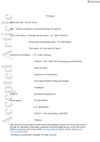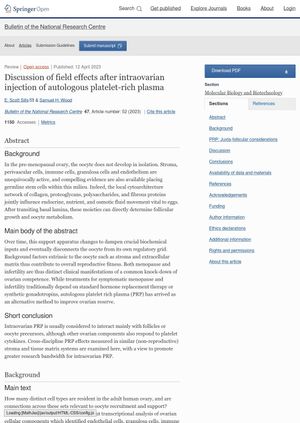TLDR The document concludes that more research is needed to understand how PRP affects the ovaries and to standardize its use in treatment.
The document discusses the potential of autologous platelet-rich plasma (PRP) as an alternative treatment to improve ovarian reserve in pre-menopausal women. It suggests that intraovarian PRP may interact not only with follicles or oocyte precursors but also with other ovarian components like stroma, perivascular cells, immune cells, granulosa cells, and endothelium that respond to platelet cytokines. The study indicates that PRP could influence the ovarian microclimate, potentially affecting follicle assembly and oocyte competency. However, the document concludes that further research is needed to understand the specific ovarian stromal responses following PRP and calls for standardization in PRP processing techniques and injection methods to increase its clinical use.
 11 citations
,
May 2021 in “Journal of Cosmetic Dermatology”
11 citations
,
May 2021 in “Journal of Cosmetic Dermatology” Platelet-rich plasma therapy could be an effective treatment for melasma with minimal side effects.
 25 citations
,
May 2020 in “Daehan saengsik uihak hoeji/Clinical and experimental reproductive medicine”
25 citations
,
May 2020 in “Daehan saengsik uihak hoeji/Clinical and experimental reproductive medicine” Injecting platelet-derived growth factors into ovaries may improve IVF outcomes by enhancing egg quality and embryo health.
November 2025 in “International Journal of Molecular Sciences” PRP shows promise in healing and regeneration but needs standardized protocols for consistent results.
 31 citations
,
March 2020 in “International Journal of Regenerative Medicine”
31 citations
,
March 2020 in “International Journal of Regenerative Medicine” PRP treatment can safely boost hormone levels in some IVF patients with low ovarian reserve.
34 citations
,
January 2022 in “Human Reproduction Open” PRP injections did not significantly improve ovarian function in women with low ovarian reserve.
 25 citations
,
May 2020 in “Daehan saengsik uihak hoeji/Clinical and experimental reproductive medicine”
25 citations
,
May 2020 in “Daehan saengsik uihak hoeji/Clinical and experimental reproductive medicine” Injecting platelet-derived growth factors into ovaries may improve IVF outcomes by enhancing egg quality and embryo health.
 15 citations
,
August 2022 in “Daehan saengsik uihak hoeji/Clinical and experimental reproductive medicine”
15 citations
,
August 2022 in “Daehan saengsik uihak hoeji/Clinical and experimental reproductive medicine” Platelet-rich plasma may improve embryo genetics in IVF.




